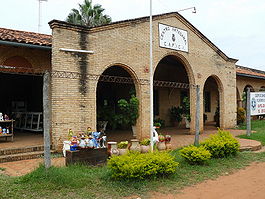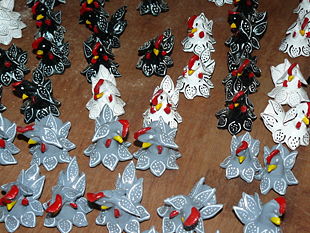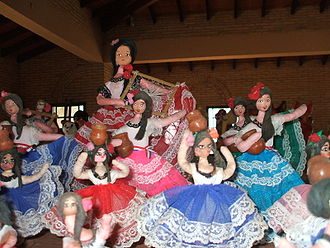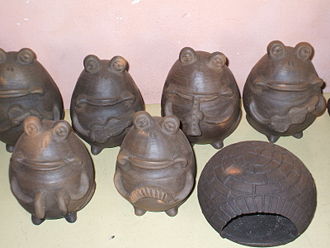
Itá, Paraguay
Encyclopedia
Itá is a city located along the 35th kilometer of Ruta 1 in the central department of Paraguay
. Here, one of the most beautiful handicrafts in the country is made: ceramic pottery and crocheted hammocks, some of whose admirable artists have been recognized with important international awards.
Itá was a city of Paraguay
, Central Department
, located 37 km from Asunción
.

According to other derives from the landscape that is love of the hills in the background that every ston
, a town inhabited by natural Guarani. It is a district since 1884.
Itá begins with a mestizo population with customs and traditions, turning with the passage of time very original, which were gradually lost, not to be disseminated or lack of knowledge, why are not valued or transmitted to its fair measure .
Itá is known and regarded as the city's "pitcher and honey" because in times of reducing the Franciscan Friar Thomas Aquinas was dedicated to teaching women instead of a new way of livelihood which was preparing of the vessels that gave the name of pitcher made of mud, seeing that mud abounded at the scene but could sell and get gain, plus it was a very useful and it would be nice to keep the flavor and freshness of mineral water.
The production of honey cane emerges from the first settlers, is this picturesque city and also involved the cultivation since the land was suitable for growing sugarcane. Displaying the properties they had sought ways to make it a food fresh, nutritious and above all natural. The city of Itá besides being identified by these 2 reasons, it is also known for its unmatched beauty and craftsmanship, besides having plenty of figures representing both nationally and internationally.
There is another story relates that within that gap is a bell buried gold, so that the invaders of wartime not carry as a trophy of war.

From Itá, for a detour of Route you can reach Itauguá already Guarambaré.

Visit and tour of the market, tourism gastronomic seafood meal on the market only in the country for its flavor and characteristics.
In San Blas Craft Center located on Route I, in the city centre, is the permanent exhibition of pottery, ceramics Guarani-Hispanic, pitchers, blankets and other excellent work.
Residents also engaged in the manufacture of beautiful cloth dolls.
The lagoon Itá, "Acosta Ñú Martyrs " which has never dried, is a very peculiar place.
In the Cerro Arrúa'i cave is a mysterious and beautiful resorts on the Arroyo Paranambú.
In addition, the Church of San Blas is a Franciscan church dating from 1698, considered historical relic.
You can make adventure tourism (Hunting, Fishing, safari photos, centered, the path of former Mariscal Lopez) in the company Arruai camps and stays in place.

All from Itá.
Paraguay
Paraguay , officially the Republic of Paraguay , is a landlocked country in South America. It is bordered by Argentina to the south and southwest, Brazil to the east and northeast, and Bolivia to the northwest. Paraguay lies on both banks of the Paraguay River, which runs through the center of the...
. Here, one of the most beautiful handicrafts in the country is made: ceramic pottery and crocheted hammocks, some of whose admirable artists have been recognized with important international awards.
Itá was a city of Paraguay
Paraguay
Paraguay , officially the Republic of Paraguay , is a landlocked country in South America. It is bordered by Argentina to the south and southwest, Brazil to the east and northeast, and Bolivia to the northwest. Paraguay lies on both banks of the Paraguay River, which runs through the center of the...
, Central Department
Central Department
Central is a department in Paraguay. The capital is Areguá. With its 1,929,834 inhabitants it is the most populated of the 17 departments of Paraguay.-Boundaries:*North: the departments of Cordillera and Presidente Hayes....
, located 37 km from Asunción
Asunción
Asunción is the capital and largest city of Paraguay.The "Ciudad de Asunción" is an autonomous capital district not part of any department. The metropolitan area, called Gran Asunción, includes the cities of San Lorenzo, Fernando de la Mora, Lambaré, Luque, Mariano Roque Alonso, Ñemby, San...
.

Etymology
Its name means "stone" in the sweet Guarani, also known as the "Capital of Ceramics".According to other derives from the landscape that is love of the hills in the background that every ston
Weather
The maximum temperature in summer reaches 40 °C, at times, this is outdated. The minimum in winter is 0 °C. The average in the central department is 22 °C. It is located in one of the departments in which rainfall is most abundant from January to April and scarcer from June to August.Demography
Itá has a total of 81,084 inhabitants, of whom 40,708 were males and 40,377 females, according to projections from the Directorate General of Statistics, Census and Surveys.History
Founded in 1539 Governor Domingo Martínez de IralaDomingo Martínez de Irala
Domingo Martínez de Irala was a Spanish Basque conquistador.He headed for the Americas in 1535 enrolled in the expedition of Pedro de Mendoza and participated in the founding of Buenos Aires...
, a town inhabited by natural Guarani. It is a district since 1884.
Itá begins with a mestizo population with customs and traditions, turning with the passage of time very original, which were gradually lost, not to be disseminated or lack of knowledge, why are not valued or transmitted to its fair measure .
Itá is known and regarded as the city's "pitcher and honey" because in times of reducing the Franciscan Friar Thomas Aquinas was dedicated to teaching women instead of a new way of livelihood which was preparing of the vessels that gave the name of pitcher made of mud, seeing that mud abounded at the scene but could sell and get gain, plus it was a very useful and it would be nice to keep the flavor and freshness of mineral water.
The production of honey cane emerges from the first settlers, is this picturesque city and also involved the cultivation since the land was suitable for growing sugarcane. Displaying the properties they had sought ways to make it a food fresh, nutritious and above all natural. The city of Itá besides being identified by these 2 reasons, it is also known for its unmatched beauty and craftsmanship, besides having plenty of figures representing both nationally and internationally.
History of the Itá Lagoon
According to some residents of the city of Itá, which in wartime large armies that passed through that place an elderly woman who lived in the interior of his house had a well, the soldiers called thirsty to drink water and the old woman refused to give not only them but everyone who asked to drink and then fell into a flood, which flooded the entire house until they formed a lagoon.There is another story relates that within that gap is a bell buried gold, so that the invaders of wartime not carry as a trophy of war.
Communities
| Name | Population |
|---|---|
| Yjhovy | 1435 |
| Potrero Po’i | 2046 |
| Itá Potrero | 1063 |
| Valle Jo’a | 245 |
| Oculto Chircaty | 780 |
| Arrua’i | 2833 |
| Curupicayty | 1468 |
| Peguaho | 1289 |
| Jhugua Ñaró | 1185 |
| Calle Ybaté | 1185 |
| Calle Po’i | 193 |
| Tapé Tuyá | 497 |
| Posta Gaona | 1591 |
| Aveiro | 2033 |
| Caaguazu'i | 2204 |
| Caraguataity | 286 |
| Las Piedras | 2507 |
Itá neighborhoods

| Name |
|---|
| Neighborhood San Blas |
| Neighborhood Sportivo |
| Neighborhood Cerro Corá |
| Neighborhood San Antonio |
| Neighborhood Villa Rossana I and II |
| Neighborhood Paranambu |
| Neighborhood San Cayetano |
| Neighborhood San Miguel |
Economy
Residents of Itá engaged in agriculture and pottery, and lately also to trade the adventure tourism (in the company Arruaí) in addition to the very peculiar characteristics are the use of black pottery.Transportation
Itá is far 37 kilometers from Asunción, on Route I Mariscal Francisco Solano López, another route is widely used to reach the so-called "Southern Access".From Itá, for a detour of Route you can reach Itauguá already Guarambaré.

Tourism
The city is one of the most significant reductions Franciscan. The people of Itá retain this feature in their habits: development of handicrafts in manufacture of ceramics and baskets.Visit and tour of the market, tourism gastronomic seafood meal on the market only in the country for its flavor and characteristics.
In San Blas Craft Center located on Route I, in the city centre, is the permanent exhibition of pottery, ceramics Guarani-Hispanic, pitchers, blankets and other excellent work.
Residents also engaged in the manufacture of beautiful cloth dolls.
The lagoon Itá, "Acosta Ñú Martyrs " which has never dried, is a very peculiar place.
In the Cerro Arrúa'i cave is a mysterious and beautiful resorts on the Arroyo Paranambú.
In addition, the Church of San Blas is a Franciscan church dating from 1698, considered historical relic.
You can make adventure tourism (Hunting, Fishing, safari photos, centered, the path of former Mariscal Lopez) in the company Arruai camps and stays in place.
Notable people
- The potter, Rosa BrítezRosa BrítezRosa Brítez is a popular Paraguayan artisan, born in Ita , city of the Central Department of Paraguay, on April 9, 1941.She has a very particular style and she dedicates to mold in clay decorative and representative figures of her country. These objects are very valued in Paraguay as well as in...
, declared, for their wonderful work, "Potter of América." - The great ceramists Juana and Julia Isidrez, creditor Prize Dutch "Prince Klaus" by their works.

- Marciana Rojas
- Gregoria Benítez
- Estanislao Agüero
- Celso Felipe Benítez
- Mercedes Servín
- Fredy Fretes
- Familia Jiménez
All from Itá.
- Professor Celso Bazán with the conservatory Herminio Gimenez.

